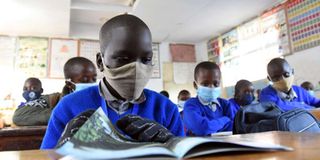If we are to improve the quality of learning, we need to do more

Kilimani Primary School grade 4 pupils in class on January 4, 2021 when schools countrywide were reopened.
What you need to know:
- Education CS George Magoha and his team have done pretty well in ensuring that children are safe from the virus.
- But more can be done, especially in the building of classrooms, and supplying of desks, masks, hand sanitisers and learning materials.
Millions of learners are now in school after spending nearly 10 months out of class, thanks to Covid-19.
Not only are they excited to be reunited with their schoolmates but they are also glad to be continuing with their education in order to achieve their dreams.
Education Cabinet Secretary George Magoha and his team have done pretty well in ensuring that children are safe from the virus that refuses to go away a year later.
But more can be done, especially in the building of classrooms, and supplying of desks, masks, hand sanitisers and learning materials such as books and other stationery.
It should not be forgotten that, for a long time, Kenya has had a reputable education system that has produced students who won admission into world renowned Ivy League universities such as Harvard and Yale.
Many other Kenyan graduates have been the drivers of landmark innovations around the globe. And, for this to continue, more emphasis needs to be placed on the quality of education offered in our schools, right from pre-school.
It is admirable that the government has been hard at work, rolling out a new curriculum, but much more can be done.
Since I joined school, the learner-teacher ratio has been a major bottleneck in Kenya’s quest to improve the quality of education.
Quality of education
Latest available statistics show that the Pupil-Teacher Ratio (PTR) in public primary schools stands at 56:1 against the recommended 40:1, while the Student-Teacher-Ratio (STR) stands at 41:1 in public secondary schools.
If the government keeps up with the teacher hiring drive it started in 2018, then this gap can be closed.
Related to this, infrastructure in public schools continues to be either inadequate or in a derelict state.
Classrooms and even washrooms continue to be few and in bad shape in many schools countrywide.
Some secondary schools lack science laboratories, and some of those that have, lack chemical reagents. If not addressed, this could greatly hamper the quality of education.
It is impossible to imagine how a test tube or a crucible looks like during chemistry lessons.
The government should strive to continually increase the budgetary allocation to the education sector even as it fights corruption.
If the government continues to put emphasis not only on accessibility but also on the quality of education, then Kenya would be a great place to live.
Lewis-Miller Kaphira, 19, is a second year student of Economics and Statistics at Kenyatta University.
Are you aged 10-20 and would like to be Nation’s young reporter? Email your 400-600-word article to [email protected]




